Analysis of the Elizabeth Quay Project: Project Management Report
VerifiedAdded on 2022/05/11
|47
|10449
|22
Report
AI Summary
This report provides a comprehensive analysis of the Elizabeth Quay project in Perth, focusing on project management principles and practices. It begins with an introduction, outlining the purpose and scope of the report, followed by a detailed description of the project's background and scope. The report then delves into an analysis of project management charts, including the Work Breakdown Structure (WBS), scheduling, Gantt chart, and critical path, demonstrating their application in the project. Challenges faced during the project, such as coordination issues and scope changes, are discussed. The report also explores best practices and new approaches in engineering project management, emphasizing leadership functions. Finally, it offers recommendations for improvement and concludes with lessons learned from the project, providing a valuable resource for students studying project management, with access to past papers and solved assignments on Desklib.
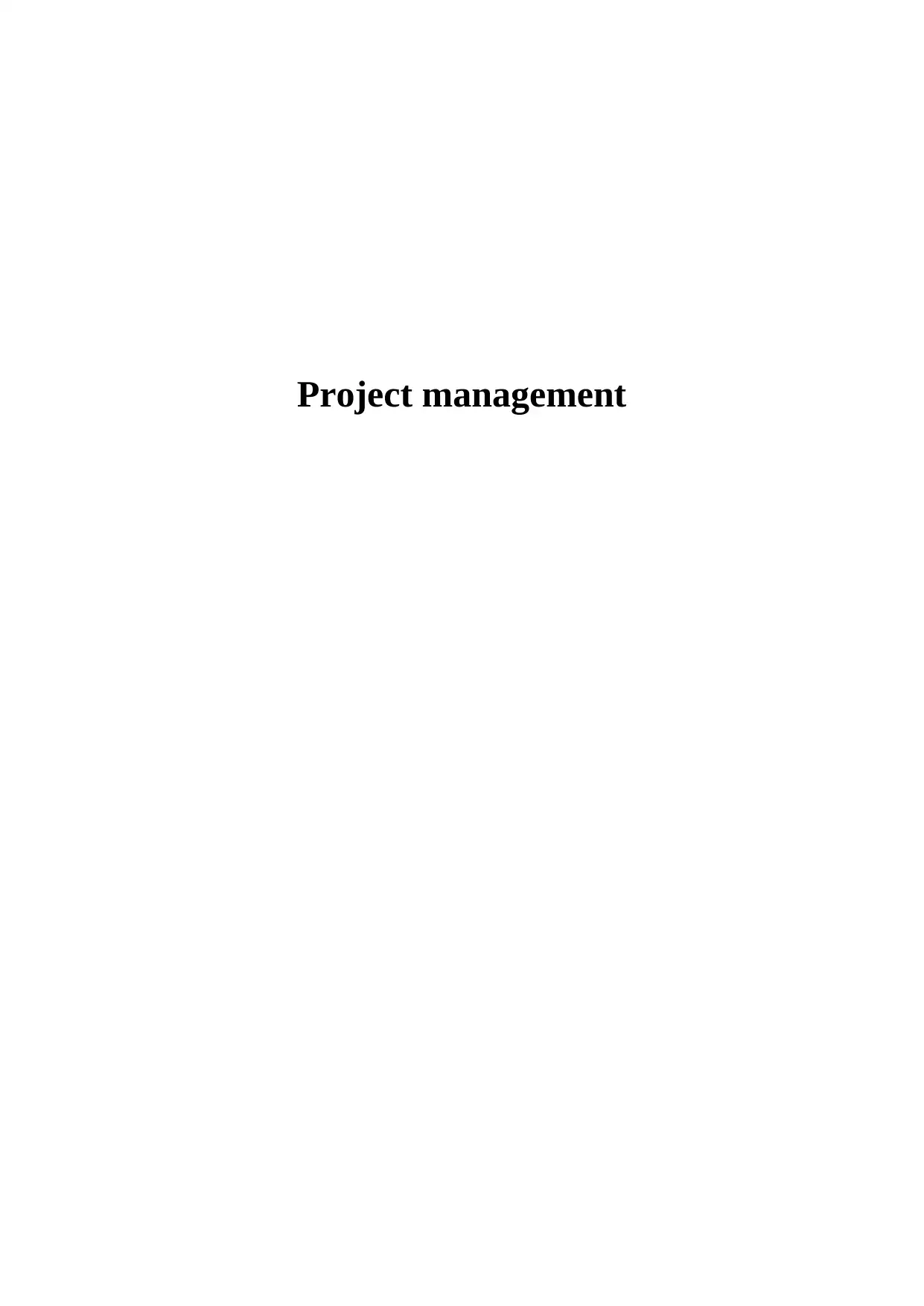
Project management
Paraphrase This Document
Need a fresh take? Get an instant paraphrase of this document with our AI Paraphraser
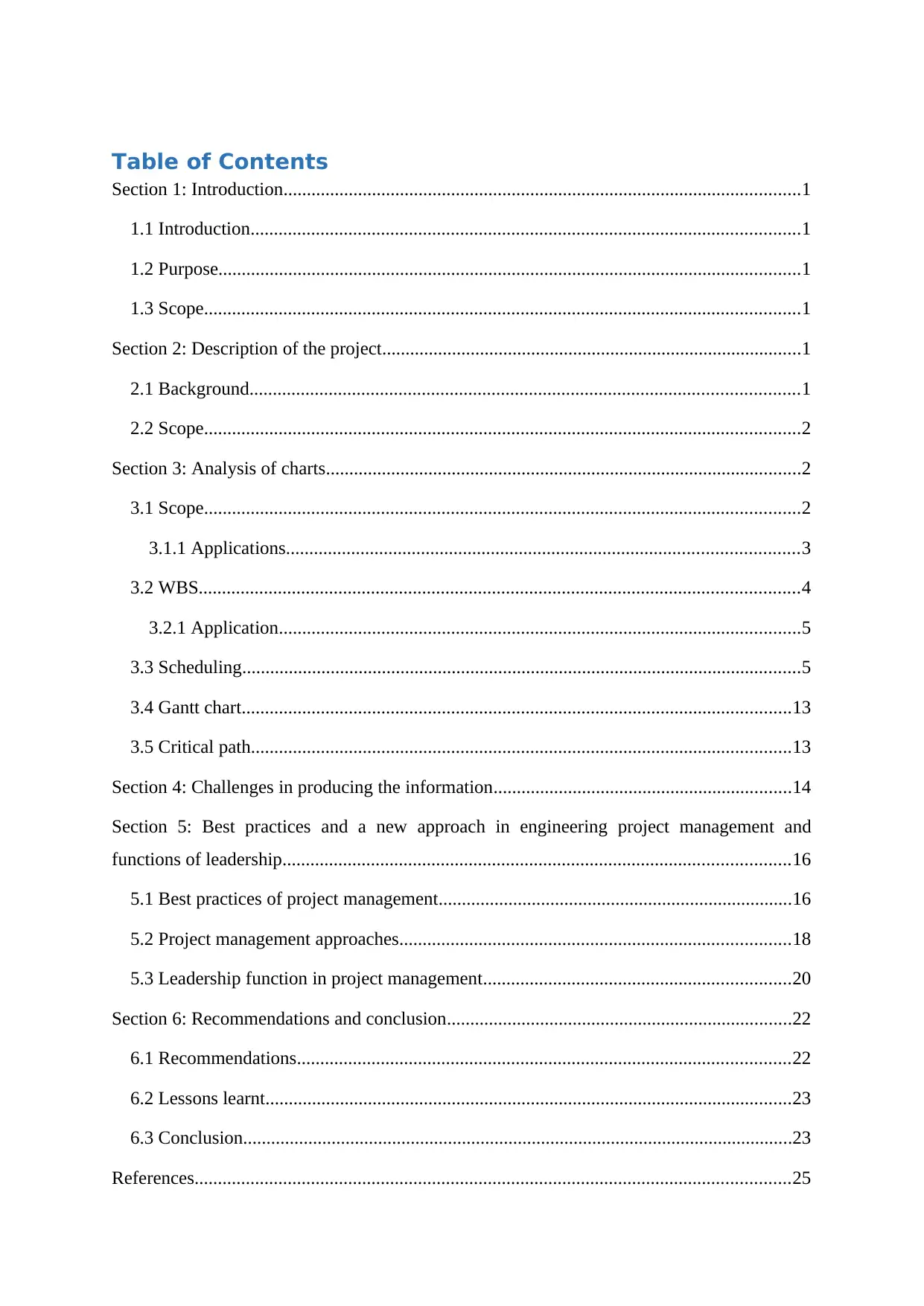
Table of Contents
Section 1: Introduction...............................................................................................................1
1.1 Introduction......................................................................................................................1
1.2 Purpose.............................................................................................................................1
1.3 Scope................................................................................................................................1
Section 2: Description of the project..........................................................................................1
2.1 Background......................................................................................................................1
2.2 Scope................................................................................................................................2
Section 3: Analysis of charts......................................................................................................2
3.1 Scope................................................................................................................................2
3.1.1 Applications..............................................................................................................3
3.2 WBS.................................................................................................................................4
3.2.1 Application................................................................................................................5
3.3 Scheduling........................................................................................................................5
3.4 Gantt chart......................................................................................................................13
3.5 Critical path....................................................................................................................13
Section 4: Challenges in producing the information................................................................14
Section 5: Best practices and a new approach in engineering project management and
functions of leadership.............................................................................................................16
5.1 Best practices of project management............................................................................16
5.2 Project management approaches....................................................................................18
5.3 Leadership function in project management..................................................................20
Section 6: Recommendations and conclusion..........................................................................22
6.1 Recommendations..........................................................................................................22
6.2 Lessons learnt.................................................................................................................23
6.3 Conclusion......................................................................................................................23
References................................................................................................................................25
Section 1: Introduction...............................................................................................................1
1.1 Introduction......................................................................................................................1
1.2 Purpose.............................................................................................................................1
1.3 Scope................................................................................................................................1
Section 2: Description of the project..........................................................................................1
2.1 Background......................................................................................................................1
2.2 Scope................................................................................................................................2
Section 3: Analysis of charts......................................................................................................2
3.1 Scope................................................................................................................................2
3.1.1 Applications..............................................................................................................3
3.2 WBS.................................................................................................................................4
3.2.1 Application................................................................................................................5
3.3 Scheduling........................................................................................................................5
3.4 Gantt chart......................................................................................................................13
3.5 Critical path....................................................................................................................13
Section 4: Challenges in producing the information................................................................14
Section 5: Best practices and a new approach in engineering project management and
functions of leadership.............................................................................................................16
5.1 Best practices of project management............................................................................16
5.2 Project management approaches....................................................................................18
5.3 Leadership function in project management..................................................................20
Section 6: Recommendations and conclusion..........................................................................22
6.1 Recommendations..........................................................................................................22
6.2 Lessons learnt.................................................................................................................23
6.3 Conclusion......................................................................................................................23
References................................................................................................................................25
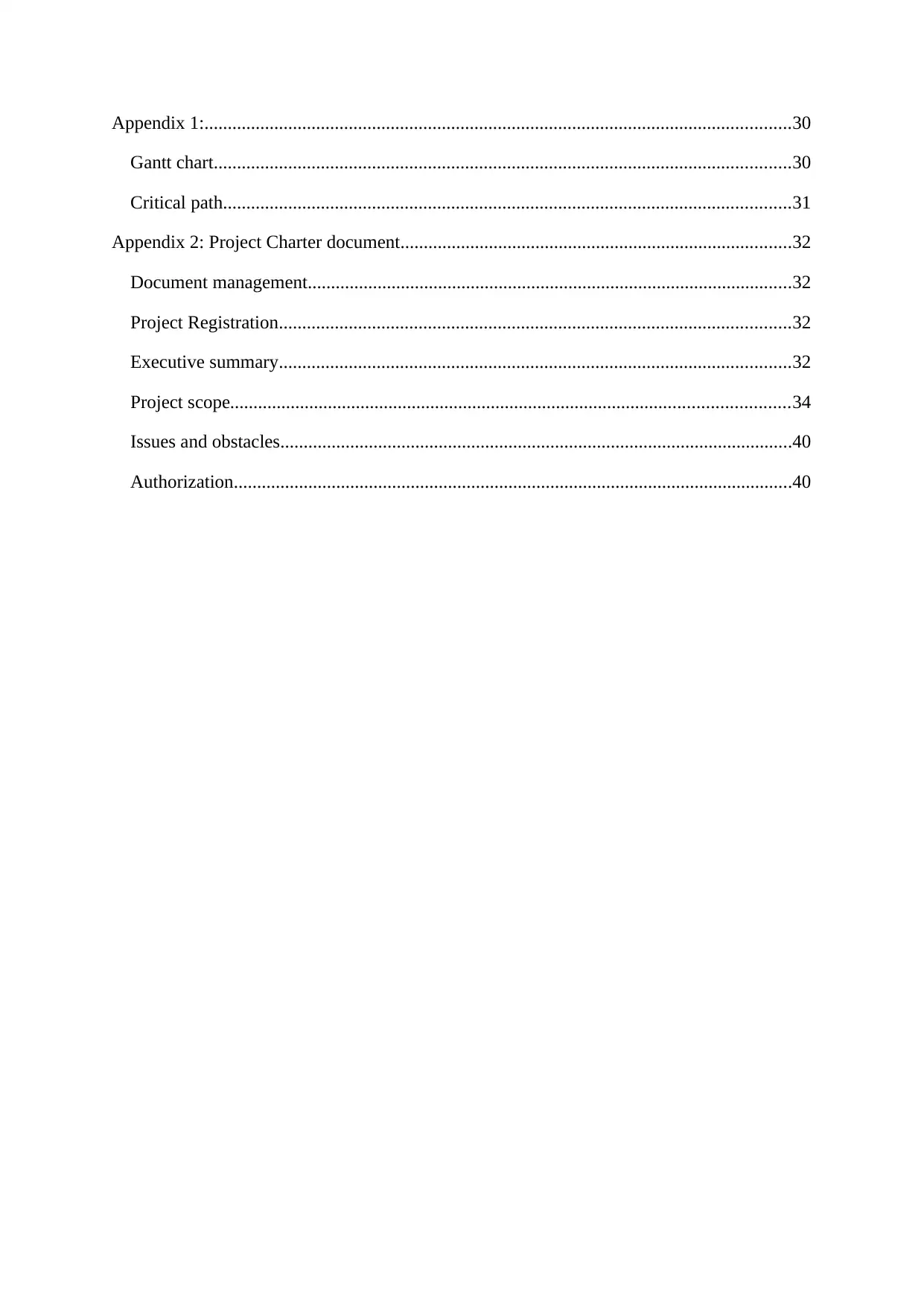
Appendix 1:..............................................................................................................................30
Gantt chart............................................................................................................................30
Critical path..........................................................................................................................31
Appendix 2: Project Charter document....................................................................................32
Document management........................................................................................................32
Project Registration..............................................................................................................32
Executive summary..............................................................................................................32
Project scope........................................................................................................................34
Issues and obstacles..............................................................................................................40
Authorization........................................................................................................................40
Gantt chart............................................................................................................................30
Critical path..........................................................................................................................31
Appendix 2: Project Charter document....................................................................................32
Document management........................................................................................................32
Project Registration..............................................................................................................32
Executive summary..............................................................................................................32
Project scope........................................................................................................................34
Issues and obstacles..............................................................................................................40
Authorization........................................................................................................................40
⊘ This is a preview!⊘
Do you want full access?
Subscribe today to unlock all pages.

Trusted by 1+ million students worldwide

List of figures
Figure 1: WBS............................................................................................................................4
Figure 2: Leadership functions.................................................................................................21
Figure 3: Gantt chart................................................................................................................26
Figure 4: Critical path..............................................................................................................27
Figure 1: WBS............................................................................................................................4
Figure 2: Leadership functions.................................................................................................21
Figure 3: Gantt chart................................................................................................................26
Figure 4: Critical path..............................................................................................................27
Paraphrase This Document
Need a fresh take? Get an instant paraphrase of this document with our AI Paraphraser

List of tables
Table 1: Schedule of project......................................................................................................5
Table 1: Schedule of project......................................................................................................5
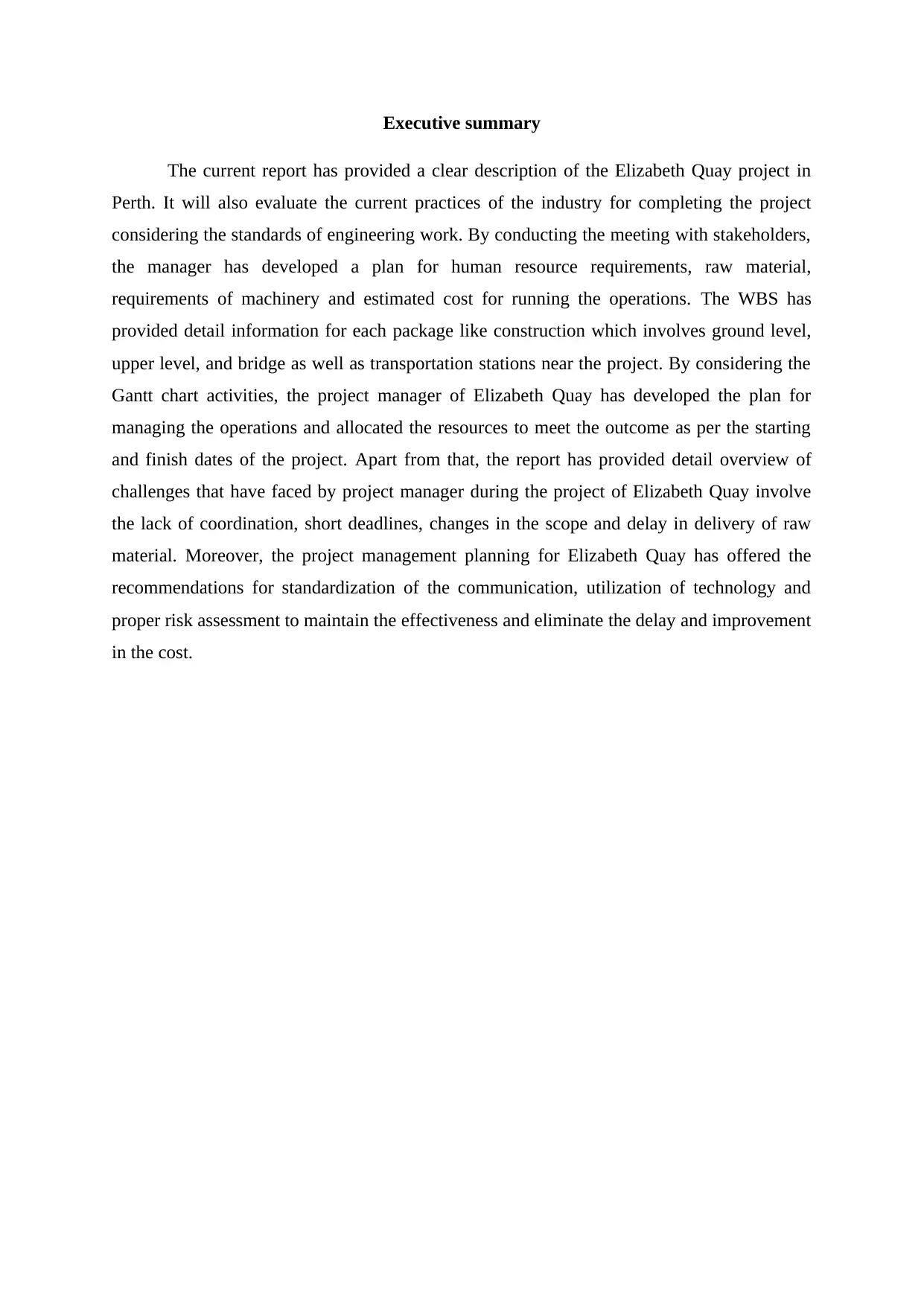
Executive summary
The current report has provided a clear description of the Elizabeth Quay project in
Perth. It will also evaluate the current practices of the industry for completing the project
considering the standards of engineering work. By conducting the meeting with stakeholders,
the manager has developed a plan for human resource requirements, raw material,
requirements of machinery and estimated cost for running the operations. The WBS has
provided detail information for each package like construction which involves ground level,
upper level, and bridge as well as transportation stations near the project. By considering the
Gantt chart activities, the project manager of Elizabeth Quay has developed the plan for
managing the operations and allocated the resources to meet the outcome as per the starting
and finish dates of the project. Apart from that, the report has provided detail overview of
challenges that have faced by project manager during the project of Elizabeth Quay involve
the lack of coordination, short deadlines, changes in the scope and delay in delivery of raw
material. Moreover, the project management planning for Elizabeth Quay has offered the
recommendations for standardization of the communication, utilization of technology and
proper risk assessment to maintain the effectiveness and eliminate the delay and improvement
in the cost.
The current report has provided a clear description of the Elizabeth Quay project in
Perth. It will also evaluate the current practices of the industry for completing the project
considering the standards of engineering work. By conducting the meeting with stakeholders,
the manager has developed a plan for human resource requirements, raw material,
requirements of machinery and estimated cost for running the operations. The WBS has
provided detail information for each package like construction which involves ground level,
upper level, and bridge as well as transportation stations near the project. By considering the
Gantt chart activities, the project manager of Elizabeth Quay has developed the plan for
managing the operations and allocated the resources to meet the outcome as per the starting
and finish dates of the project. Apart from that, the report has provided detail overview of
challenges that have faced by project manager during the project of Elizabeth Quay involve
the lack of coordination, short deadlines, changes in the scope and delay in delivery of raw
material. Moreover, the project management planning for Elizabeth Quay has offered the
recommendations for standardization of the communication, utilization of technology and
proper risk assessment to maintain the effectiveness and eliminate the delay and improvement
in the cost.
⊘ This is a preview!⊘
Do you want full access?
Subscribe today to unlock all pages.

Trusted by 1+ million students worldwide
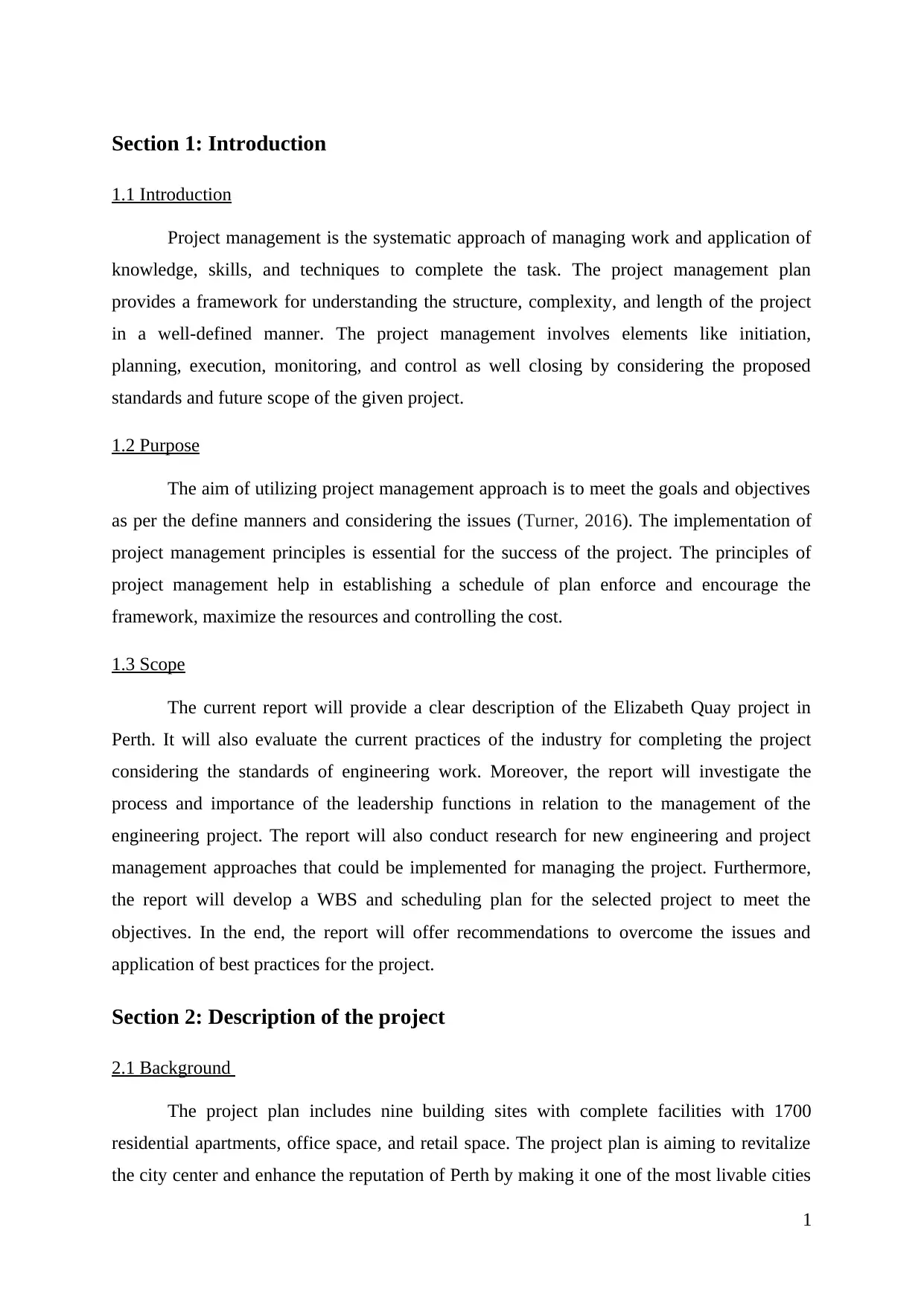
Section 1: Introduction
1.1 Introduction
Project management is the systematic approach of managing work and application of
knowledge, skills, and techniques to complete the task. The project management plan
provides a framework for understanding the structure, complexity, and length of the project
in a well-defined manner. The project management involves elements like initiation,
planning, execution, monitoring, and control as well closing by considering the proposed
standards and future scope of the given project.
1.2 Purpose
The aim of utilizing project management approach is to meet the goals and objectives
as per the define manners and considering the issues (Turner, 2016). The implementation of
project management principles is essential for the success of the project. The principles of
project management help in establishing a schedule of plan enforce and encourage the
framework, maximize the resources and controlling the cost.
1.3 Scope
The current report will provide a clear description of the Elizabeth Quay project in
Perth. It will also evaluate the current practices of the industry for completing the project
considering the standards of engineering work. Moreover, the report will investigate the
process and importance of the leadership functions in relation to the management of the
engineering project. The report will also conduct research for new engineering and project
management approaches that could be implemented for managing the project. Furthermore,
the report will develop a WBS and scheduling plan for the selected project to meet the
objectives. In the end, the report will offer recommendations to overcome the issues and
application of best practices for the project.
Section 2: Description of the project
2.1 Background
The project plan includes nine building sites with complete facilities with 1700
residential apartments, office space, and retail space. The project plan is aiming to revitalize
the city center and enhance the reputation of Perth by making it one of the most livable cities
1
1.1 Introduction
Project management is the systematic approach of managing work and application of
knowledge, skills, and techniques to complete the task. The project management plan
provides a framework for understanding the structure, complexity, and length of the project
in a well-defined manner. The project management involves elements like initiation,
planning, execution, monitoring, and control as well closing by considering the proposed
standards and future scope of the given project.
1.2 Purpose
The aim of utilizing project management approach is to meet the goals and objectives
as per the define manners and considering the issues (Turner, 2016). The implementation of
project management principles is essential for the success of the project. The principles of
project management help in establishing a schedule of plan enforce and encourage the
framework, maximize the resources and controlling the cost.
1.3 Scope
The current report will provide a clear description of the Elizabeth Quay project in
Perth. It will also evaluate the current practices of the industry for completing the project
considering the standards of engineering work. Moreover, the report will investigate the
process and importance of the leadership functions in relation to the management of the
engineering project. The report will also conduct research for new engineering and project
management approaches that could be implemented for managing the project. Furthermore,
the report will develop a WBS and scheduling plan for the selected project to meet the
objectives. In the end, the report will offer recommendations to overcome the issues and
application of best practices for the project.
Section 2: Description of the project
2.1 Background
The project plan includes nine building sites with complete facilities with 1700
residential apartments, office space, and retail space. The project plan is aiming to revitalize
the city center and enhance the reputation of Perth by making it one of the most livable cities
1
Paraphrase This Document
Need a fresh take? Get an instant paraphrase of this document with our AI Paraphraser
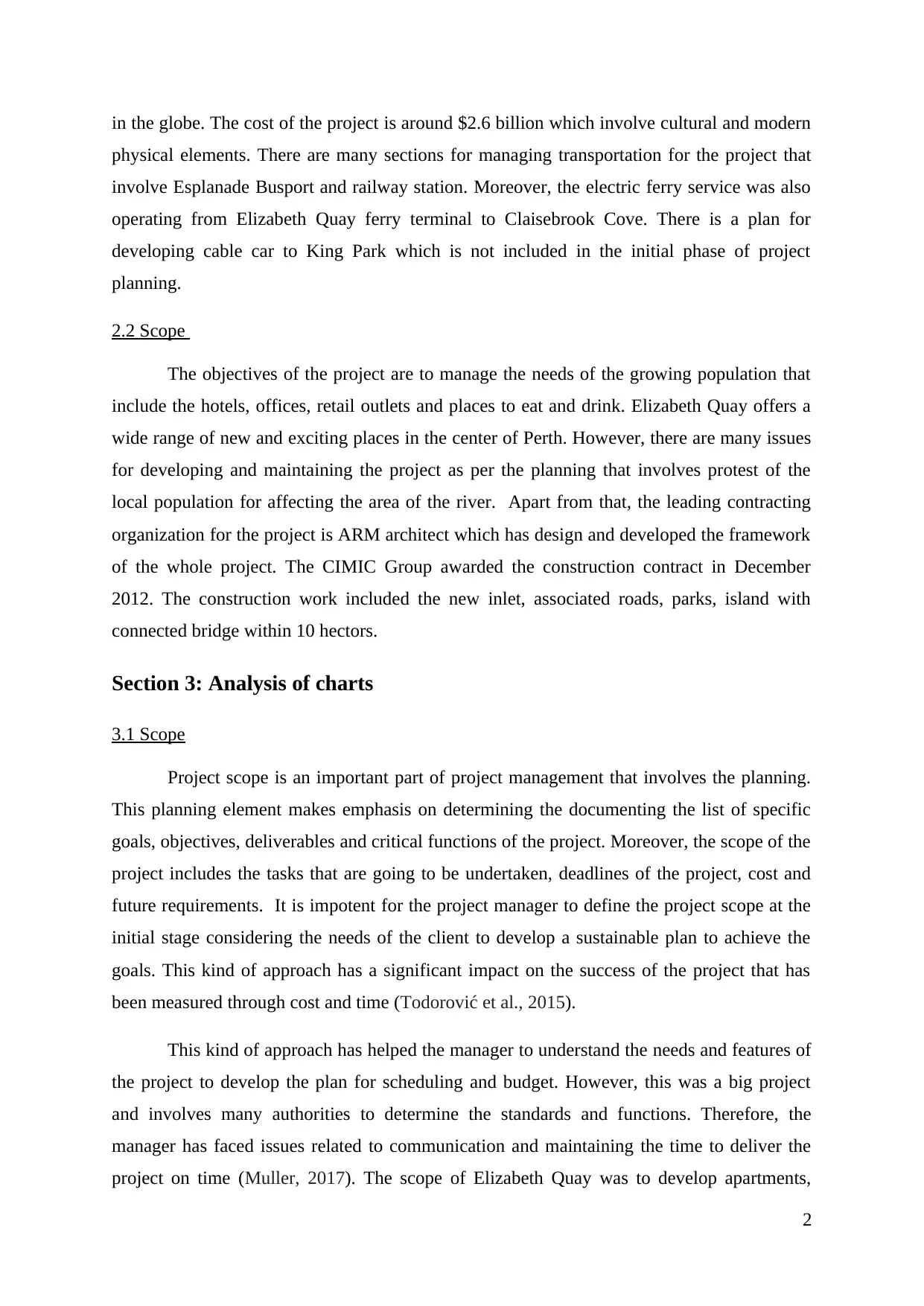
in the globe. The cost of the project is around $2.6 billion which involve cultural and modern
physical elements. There are many sections for managing transportation for the project that
involve Esplanade Busport and railway station. Moreover, the electric ferry service was also
operating from Elizabeth Quay ferry terminal to Claisebrook Cove. There is a plan for
developing cable car to King Park which is not included in the initial phase of project
planning.
2.2 Scope
The objectives of the project are to manage the needs of the growing population that
include the hotels, offices, retail outlets and places to eat and drink. Elizabeth Quay offers a
wide range of new and exciting places in the center of Perth. However, there are many issues
for developing and maintaining the project as per the planning that involves protest of the
local population for affecting the area of the river. Apart from that, the leading contracting
organization for the project is ARM architect which has design and developed the framework
of the whole project. The CIMIC Group awarded the construction contract in December
2012. The construction work included the new inlet, associated roads, parks, island with
connected bridge within 10 hectors.
Section 3: Analysis of charts
3.1 Scope
Project scope is an important part of project management that involves the planning.
This planning element makes emphasis on determining the documenting the list of specific
goals, objectives, deliverables and critical functions of the project. Moreover, the scope of the
project includes the tasks that are going to be undertaken, deadlines of the project, cost and
future requirements. It is impotent for the project manager to define the project scope at the
initial stage considering the needs of the client to develop a sustainable plan to achieve the
goals. This kind of approach has a significant impact on the success of the project that has
been measured through cost and time (Todorović et al., 2015).
This kind of approach has helped the manager to understand the needs and features of
the project to develop the plan for scheduling and budget. However, this was a big project
and involves many authorities to determine the standards and functions. Therefore, the
manager has faced issues related to communication and maintaining the time to deliver the
project on time (Muller, 2017). The scope of Elizabeth Quay was to develop apartments,
2
physical elements. There are many sections for managing transportation for the project that
involve Esplanade Busport and railway station. Moreover, the electric ferry service was also
operating from Elizabeth Quay ferry terminal to Claisebrook Cove. There is a plan for
developing cable car to King Park which is not included in the initial phase of project
planning.
2.2 Scope
The objectives of the project are to manage the needs of the growing population that
include the hotels, offices, retail outlets and places to eat and drink. Elizabeth Quay offers a
wide range of new and exciting places in the center of Perth. However, there are many issues
for developing and maintaining the project as per the planning that involves protest of the
local population for affecting the area of the river. Apart from that, the leading contracting
organization for the project is ARM architect which has design and developed the framework
of the whole project. The CIMIC Group awarded the construction contract in December
2012. The construction work included the new inlet, associated roads, parks, island with
connected bridge within 10 hectors.
Section 3: Analysis of charts
3.1 Scope
Project scope is an important part of project management that involves the planning.
This planning element makes emphasis on determining the documenting the list of specific
goals, objectives, deliverables and critical functions of the project. Moreover, the scope of the
project includes the tasks that are going to be undertaken, deadlines of the project, cost and
future requirements. It is impotent for the project manager to define the project scope at the
initial stage considering the needs of the client to develop a sustainable plan to achieve the
goals. This kind of approach has a significant impact on the success of the project that has
been measured through cost and time (Todorović et al., 2015).
This kind of approach has helped the manager to understand the needs and features of
the project to develop the plan for scheduling and budget. However, this was a big project
and involves many authorities to determine the standards and functions. Therefore, the
manager has faced issues related to communication and maintaining the time to deliver the
project on time (Muller, 2017). The scope of Elizabeth Quay was to develop apartments,
2
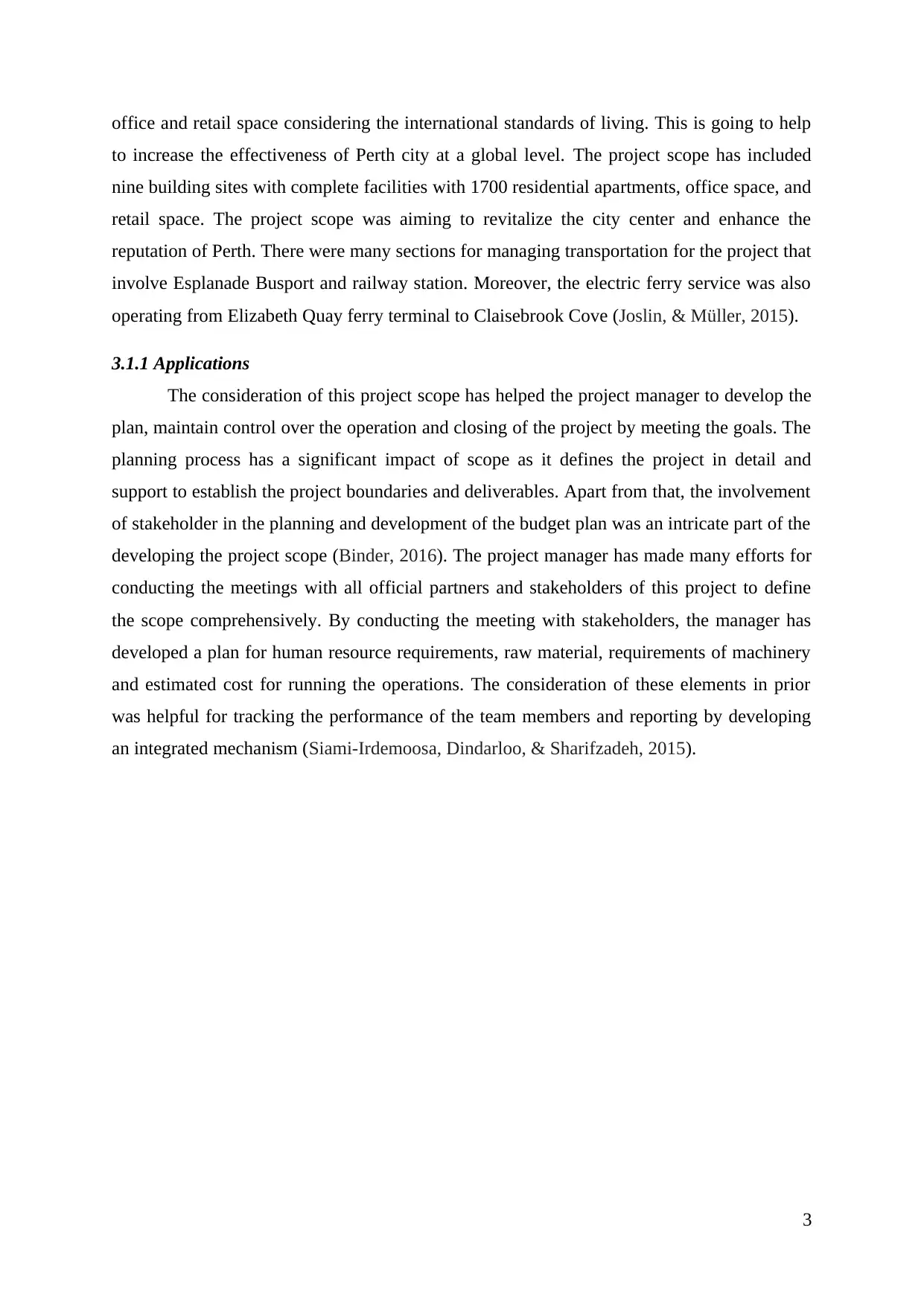
office and retail space considering the international standards of living. This is going to help
to increase the effectiveness of Perth city at a global level. The project scope has included
nine building sites with complete facilities with 1700 residential apartments, office space, and
retail space. The project scope was aiming to revitalize the city center and enhance the
reputation of Perth. There were many sections for managing transportation for the project that
involve Esplanade Busport and railway station. Moreover, the electric ferry service was also
operating from Elizabeth Quay ferry terminal to Claisebrook Cove (Joslin, & Müller, 2015).
3.1.1 Applications
The consideration of this project scope has helped the project manager to develop the
plan, maintain control over the operation and closing of the project by meeting the goals. The
planning process has a significant impact of scope as it defines the project in detail and
support to establish the project boundaries and deliverables. Apart from that, the involvement
of stakeholder in the planning and development of the budget plan was an intricate part of the
developing the project scope (Binder, 2016). The project manager has made many efforts for
conducting the meetings with all official partners and stakeholders of this project to define
the scope comprehensively. By conducting the meeting with stakeholders, the manager has
developed a plan for human resource requirements, raw material, requirements of machinery
and estimated cost for running the operations. The consideration of these elements in prior
was helpful for tracking the performance of the team members and reporting by developing
an integrated mechanism (Siami-Irdemoosa, Dindarloo, & Sharifzadeh, 2015).
3
to increase the effectiveness of Perth city at a global level. The project scope has included
nine building sites with complete facilities with 1700 residential apartments, office space, and
retail space. The project scope was aiming to revitalize the city center and enhance the
reputation of Perth. There were many sections for managing transportation for the project that
involve Esplanade Busport and railway station. Moreover, the electric ferry service was also
operating from Elizabeth Quay ferry terminal to Claisebrook Cove (Joslin, & Müller, 2015).
3.1.1 Applications
The consideration of this project scope has helped the project manager to develop the
plan, maintain control over the operation and closing of the project by meeting the goals. The
planning process has a significant impact of scope as it defines the project in detail and
support to establish the project boundaries and deliverables. Apart from that, the involvement
of stakeholder in the planning and development of the budget plan was an intricate part of the
developing the project scope (Binder, 2016). The project manager has made many efforts for
conducting the meetings with all official partners and stakeholders of this project to define
the scope comprehensively. By conducting the meeting with stakeholders, the manager has
developed a plan for human resource requirements, raw material, requirements of machinery
and estimated cost for running the operations. The consideration of these elements in prior
was helpful for tracking the performance of the team members and reporting by developing
an integrated mechanism (Siami-Irdemoosa, Dindarloo, & Sharifzadeh, 2015).
3
⊘ This is a preview!⊘
Do you want full access?
Subscribe today to unlock all pages.

Trusted by 1+ million students worldwide
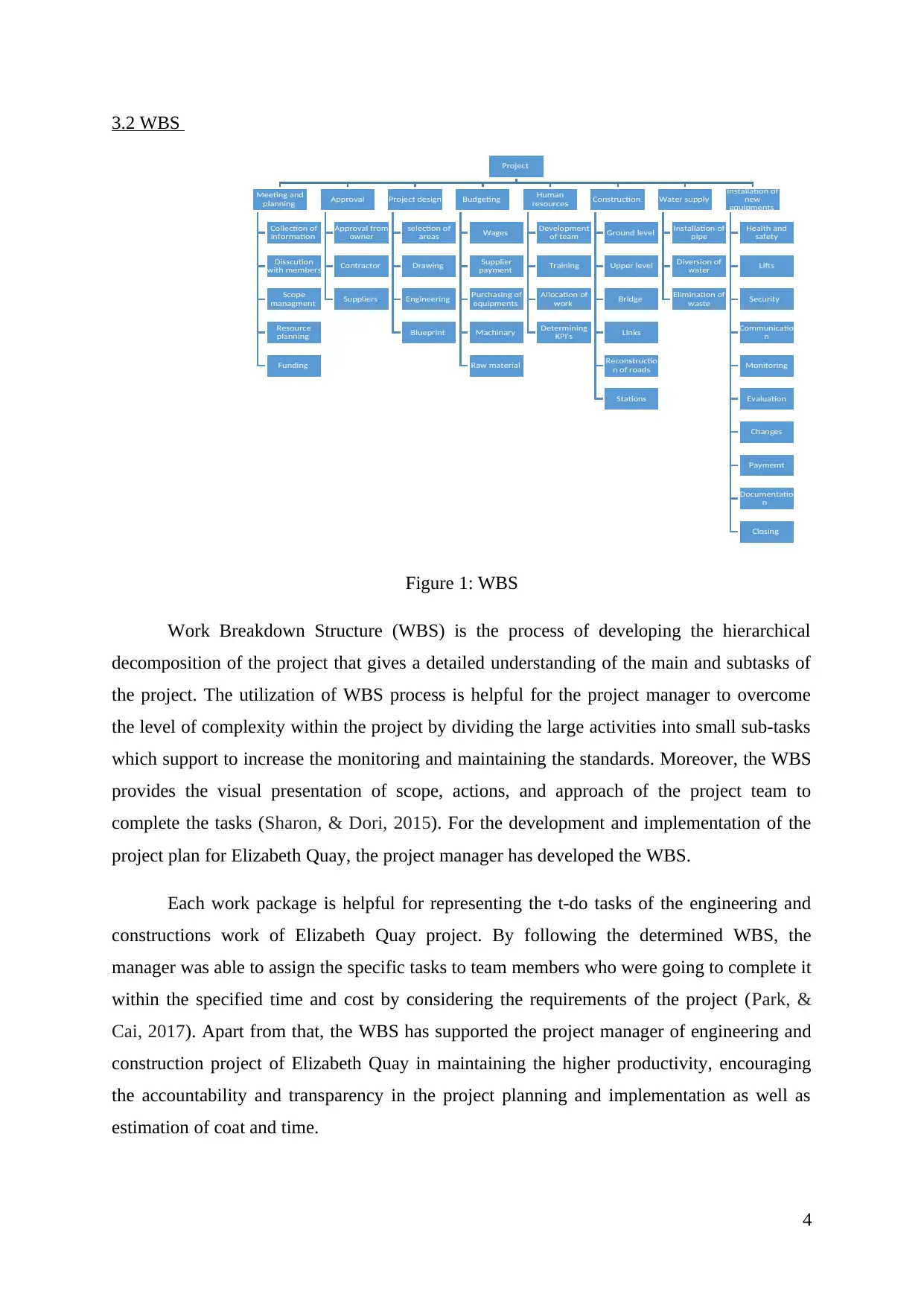
3.2 WBS
Figure 1: WBS
Work Breakdown Structure (WBS) is the process of developing the hierarchical
decomposition of the project that gives a detailed understanding of the main and subtasks of
the project. The utilization of WBS process is helpful for the project manager to overcome
the level of complexity within the project by dividing the large activities into small sub-tasks
which support to increase the monitoring and maintaining the standards. Moreover, the WBS
provides the visual presentation of scope, actions, and approach of the project team to
complete the tasks (Sharon, & Dori, 2015). For the development and implementation of the
project plan for Elizabeth Quay, the project manager has developed the WBS.
Each work package is helpful for representing the t-do tasks of the engineering and
constructions work of Elizabeth Quay project. By following the determined WBS, the
manager was able to assign the specific tasks to team members who were going to complete it
within the specified time and cost by considering the requirements of the project (Park, &
Cai, 2017). Apart from that, the WBS has supported the project manager of engineering and
construction project of Elizabeth Quay in maintaining the higher productivity, encouraging
the accountability and transparency in the project planning and implementation as well as
estimation of coat and time.
4
Project
Meeting and
planning
Collection of
information
Disscution
with members
Scope
managment
Resource
planning
Funding
Approval
Approval from
owner
Contractor
Suppliers
Project design
selection of
areas
Drawing
Engineering
Blueprint
Budgeting
Wages
Supplier
payment
Purchasing of
equipments
Machinary
Raw material
Human
resources
Development
of team
Training
Allocation of
work
Determining
KPI's
Construction
Ground level
Upper level
Bridge
Links
Reconstructio
n of roads
Stations
Water supply
Installation of
pipe
Diversion of
water
Elimination of
waste
Installation of
new
equipments
Health and
safety
Lifts
Security
Communicatio
n
Monitoring
Evaluation
Changes
Paymemt
Documentatio
n
Closing
Figure 1: WBS
Work Breakdown Structure (WBS) is the process of developing the hierarchical
decomposition of the project that gives a detailed understanding of the main and subtasks of
the project. The utilization of WBS process is helpful for the project manager to overcome
the level of complexity within the project by dividing the large activities into small sub-tasks
which support to increase the monitoring and maintaining the standards. Moreover, the WBS
provides the visual presentation of scope, actions, and approach of the project team to
complete the tasks (Sharon, & Dori, 2015). For the development and implementation of the
project plan for Elizabeth Quay, the project manager has developed the WBS.
Each work package is helpful for representing the t-do tasks of the engineering and
constructions work of Elizabeth Quay project. By following the determined WBS, the
manager was able to assign the specific tasks to team members who were going to complete it
within the specified time and cost by considering the requirements of the project (Park, &
Cai, 2017). Apart from that, the WBS has supported the project manager of engineering and
construction project of Elizabeth Quay in maintaining the higher productivity, encouraging
the accountability and transparency in the project planning and implementation as well as
estimation of coat and time.
4
Project
Meeting and
planning
Collection of
information
Disscution
with members
Scope
managment
Resource
planning
Funding
Approval
Approval from
owner
Contractor
Suppliers
Project design
selection of
areas
Drawing
Engineering
Blueprint
Budgeting
Wages
Supplier
payment
Purchasing of
equipments
Machinary
Raw material
Human
resources
Development
of team
Training
Allocation of
work
Determining
KPI's
Construction
Ground level
Upper level
Bridge
Links
Reconstructio
n of roads
Stations
Water supply
Installation of
pipe
Diversion of
water
Elimination of
waste
Installation of
new
equipments
Health and
safety
Lifts
Security
Communicatio
n
Monitoring
Evaluation
Changes
Paymemt
Documentatio
n
Closing
Paraphrase This Document
Need a fresh take? Get an instant paraphrase of this document with our AI Paraphraser
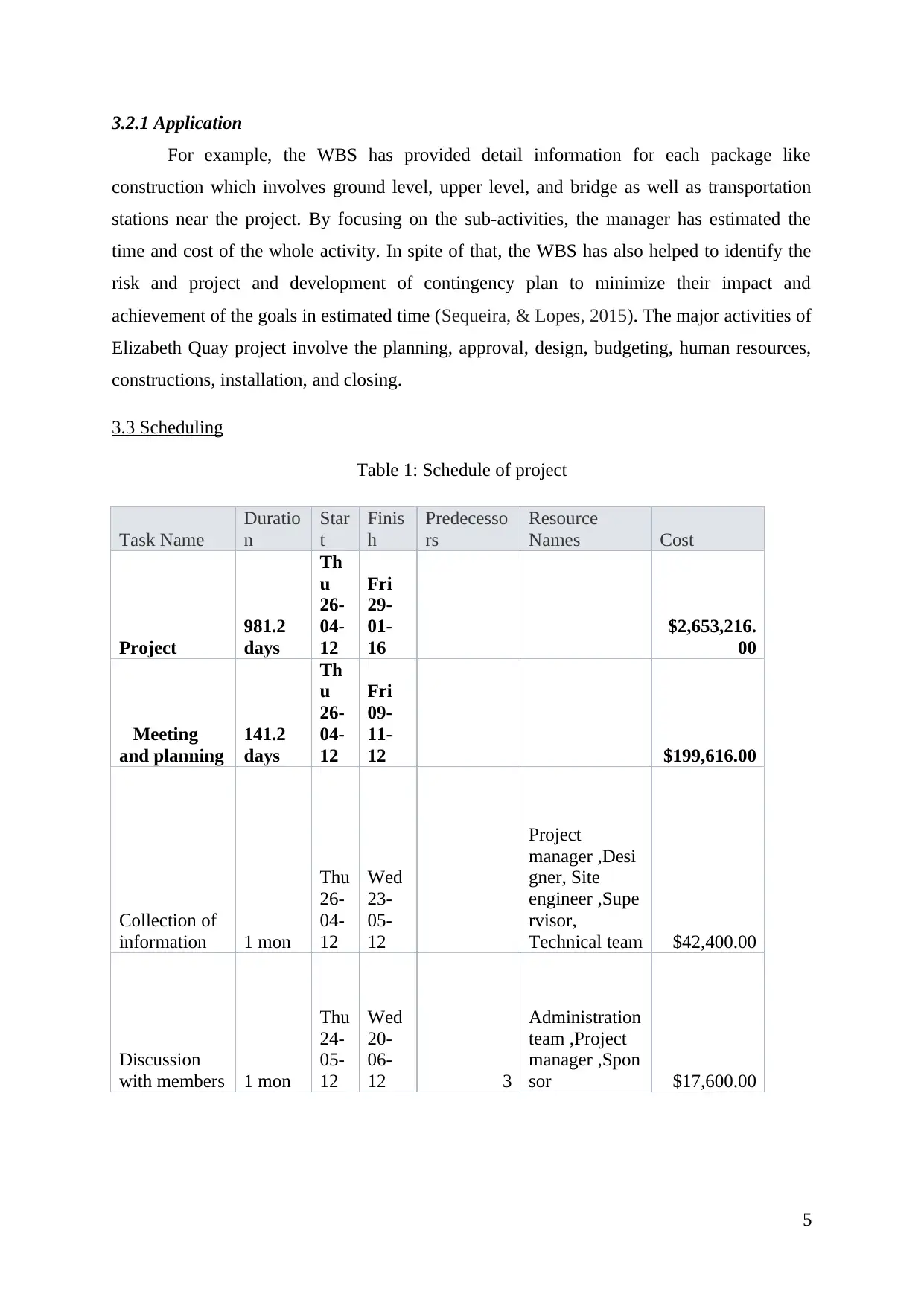
3.2.1 Application
For example, the WBS has provided detail information for each package like
construction which involves ground level, upper level, and bridge as well as transportation
stations near the project. By focusing on the sub-activities, the manager has estimated the
time and cost of the whole activity. In spite of that, the WBS has also helped to identify the
risk and project and development of contingency plan to minimize their impact and
achievement of the goals in estimated time (Sequeira, & Lopes, 2015). The major activities of
Elizabeth Quay project involve the planning, approval, design, budgeting, human resources,
constructions, installation, and closing.
3.3 Scheduling
Table 1: Schedule of project
Task Name
Duratio
n
Star
t
Finis
h
Predecesso
rs
Resource
Names Cost
Project
981.2
days
Th
u
26-
04-
12
Fri
29-
01-
16
$2,653,216.
00
Meeting
and planning
141.2
days
Th
u
26-
04-
12
Fri
09-
11-
12 $199,616.00
Collection of
information 1 mon
Thu
26-
04-
12
Wed
23-
05-
12
Project
manager ,Desi
gner, Site
engineer ,Supe
rvisor,
Technical team $42,400.00
Discussion
with members 1 mon
Thu
24-
05-
12
Wed
20-
06-
12 3
Administration
team ,Project
manager ,Spon
sor $17,600.00
5
For example, the WBS has provided detail information for each package like
construction which involves ground level, upper level, and bridge as well as transportation
stations near the project. By focusing on the sub-activities, the manager has estimated the
time and cost of the whole activity. In spite of that, the WBS has also helped to identify the
risk and project and development of contingency plan to minimize their impact and
achievement of the goals in estimated time (Sequeira, & Lopes, 2015). The major activities of
Elizabeth Quay project involve the planning, approval, design, budgeting, human resources,
constructions, installation, and closing.
3.3 Scheduling
Table 1: Schedule of project
Task Name
Duratio
n
Star
t
Finis
h
Predecesso
rs
Resource
Names Cost
Project
981.2
days
Th
u
26-
04-
12
Fri
29-
01-
16
$2,653,216.
00
Meeting
and planning
141.2
days
Th
u
26-
04-
12
Fri
09-
11-
12 $199,616.00
Collection of
information 1 mon
Thu
26-
04-
12
Wed
23-
05-
12
Project
manager ,Desi
gner, Site
engineer ,Supe
rvisor,
Technical team $42,400.00
Discussion
with members 1 mon
Thu
24-
05-
12
Wed
20-
06-
12 3
Administration
team ,Project
manager ,Spon
sor $17,600.00
5
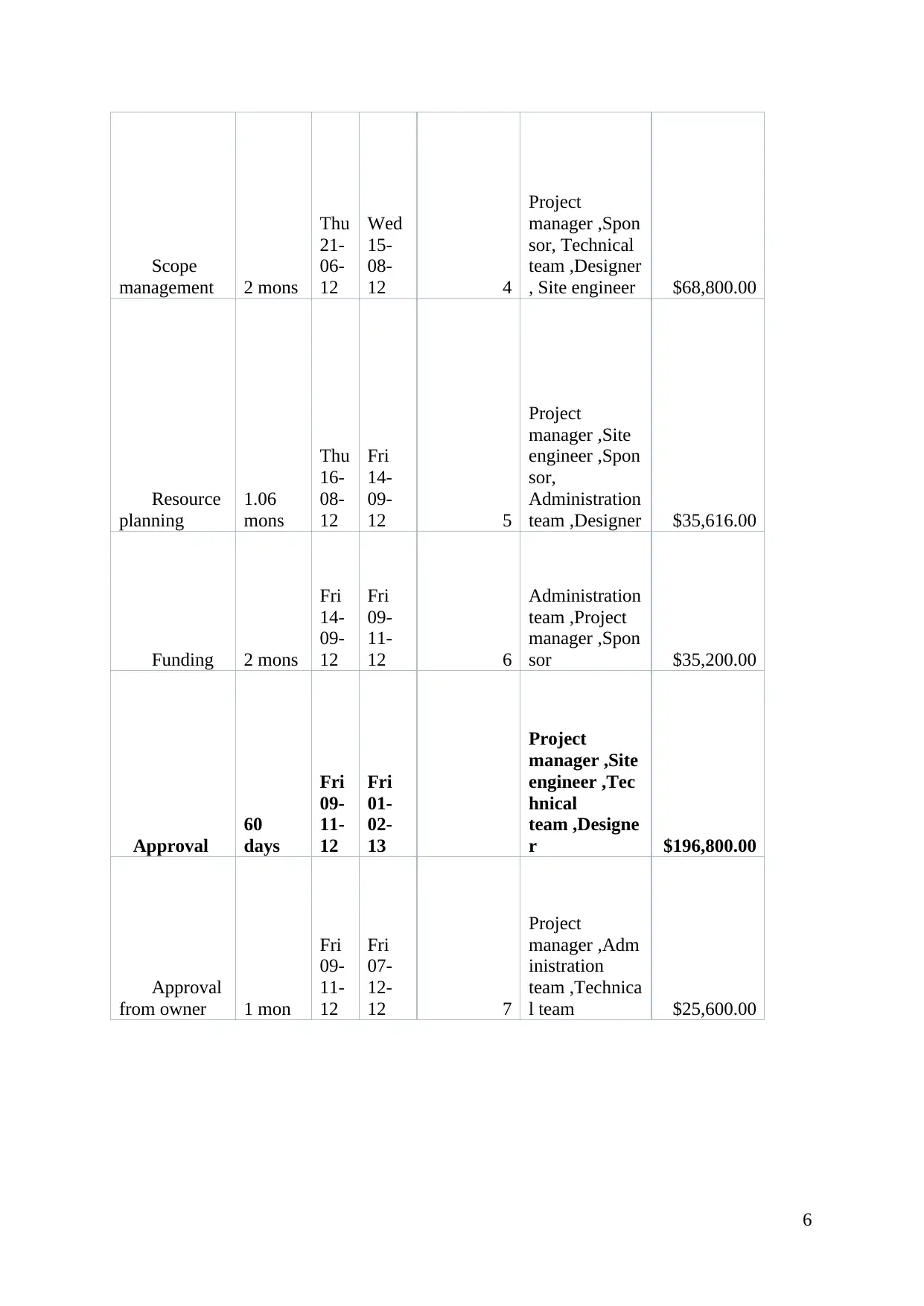
Scope
management 2 mons
Thu
21-
06-
12
Wed
15-
08-
12 4
Project
manager ,Spon
sor, Technical
team ,Designer
, Site engineer $68,800.00
Resource
planning
1.06
mons
Thu
16-
08-
12
Fri
14-
09-
12 5
Project
manager ,Site
engineer ,Spon
sor,
Administration
team ,Designer $35,616.00
Funding 2 mons
Fri
14-
09-
12
Fri
09-
11-
12 6
Administration
team ,Project
manager ,Spon
sor $35,200.00
Approval
60
days
Fri
09-
11-
12
Fri
01-
02-
13
Project
manager ,Site
engineer ,Tec
hnical
team ,Designe
r $196,800.00
Approval
from owner 1 mon
Fri
09-
11-
12
Fri
07-
12-
12 7
Project
manager ,Adm
inistration
team ,Technica
l team $25,600.00
6
management 2 mons
Thu
21-
06-
12
Wed
15-
08-
12 4
Project
manager ,Spon
sor, Technical
team ,Designer
, Site engineer $68,800.00
Resource
planning
1.06
mons
Thu
16-
08-
12
Fri
14-
09-
12 5
Project
manager ,Site
engineer ,Spon
sor,
Administration
team ,Designer $35,616.00
Funding 2 mons
Fri
14-
09-
12
Fri
09-
11-
12 6
Administration
team ,Project
manager ,Spon
sor $35,200.00
Approval
60
days
Fri
09-
11-
12
Fri
01-
02-
13
Project
manager ,Site
engineer ,Tec
hnical
team ,Designe
r $196,800.00
Approval
from owner 1 mon
Fri
09-
11-
12
Fri
07-
12-
12 7
Project
manager ,Adm
inistration
team ,Technica
l team $25,600.00
6
⊘ This is a preview!⊘
Do you want full access?
Subscribe today to unlock all pages.

Trusted by 1+ million students worldwide
1 out of 47
Related Documents
Your All-in-One AI-Powered Toolkit for Academic Success.
+13062052269
info@desklib.com
Available 24*7 on WhatsApp / Email
![[object Object]](/_next/static/media/star-bottom.7253800d.svg)
Unlock your academic potential
Copyright © 2020–2025 A2Z Services. All Rights Reserved. Developed and managed by ZUCOL.




